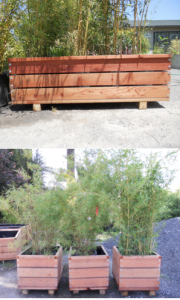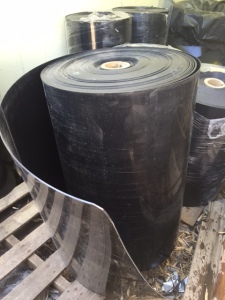Bamboo Selection
 Are you wondering how to choose the right bamboo?
Do you need a tall visual screen now?
Are you wondering how fast your bamboo might grow?
We can help you!!
When you visit the West County Oasis Bamboo Garden, our bamboo expert will take you on a private tour of our 250 species, answer your questions and direct you to the best species that will suit your needs. No appointment is necessary to visit and get a tour. This is the easiest way to get to know the plants and select the bamboo that appeals to you. Multiple visits are not unusual. This is our preferred method, but occasionally a client is unable to visit our nursery. In these cases, our bamboo expert can to visit your location and answer your questions on site. We do charge (based on distance) for on-site consultations. It is also possible to arrange phone consultations at no charge. Please check our Bamboo page that has a full listing of the plants we have available with descriptions. There are some great photos on our Gallery page. Below is some essential information about bamboo to help you make your bamboo selection. We are happy to provide this information in person and in more detail when you visit us!
Are you wondering how to choose the right bamboo?
Do you need a tall visual screen now?
Are you wondering how fast your bamboo might grow?
We can help you!!
When you visit the West County Oasis Bamboo Garden, our bamboo expert will take you on a private tour of our 250 species, answer your questions and direct you to the best species that will suit your needs. No appointment is necessary to visit and get a tour. This is the easiest way to get to know the plants and select the bamboo that appeals to you. Multiple visits are not unusual. This is our preferred method, but occasionally a client is unable to visit our nursery. In these cases, our bamboo expert can to visit your location and answer your questions on site. We do charge (based on distance) for on-site consultations. It is also possible to arrange phone consultations at no charge. Please check our Bamboo page that has a full listing of the plants we have available with descriptions. There are some great photos on our Gallery page. Below is some essential information about bamboo to help you make your bamboo selection. We are happy to provide this information in person and in more detail when you visit us!
Clumping & Wandering There are essentially two different types of bamboo; clumping and wandering (sometimes called clumping and running, or “invasive” and “non-invasive”). Bamboo is in the grass family of plants. Think about clumping grasses. They tend to be circular and dense at the base, getting a bit bigger in diameter at the base as the plant grows. In the case of clumping bamboos, new canes can come up only about two to four inches from the mother plant. Clumping bamboos are physically unable to grow any further from the mother plant. Wandering bamboos, however, send out underground rhizomes that can come up a good distance from the mother plant—as much as ten feet on a mature plant, sometimes more, sometimes less. We always recommend containment of wandering types of bamboo. If you are trying to create a screen or visual barrier with bamboo, often the wandering types are more appropriate. Wandering bamboos will fill in a designated area quickly from top to bottom. Clumping types may fill in across the top but are more like discrete shrubs and will take much longer to fill in the spaces between plants at the base.
Containment
 Containment is not necessary for clumping species of bamboo. Just make sure to provide the plant with space to grow, just as you would when planting any shrub. Remember, like any plant, the bamboo will want room to mature. Containment for wandering types can be achieved in a variety of ways. Wandering types can be planted in containers. We build redwood boxes to suit, specifically designed to hold bamboo. Our containers are lined with rhizome barrier and reinforced to contain bamboo. Let us know what size you need and we will build them. If you like we can also deliver, place the boxes and install the plants. Some folks like galvanized stock tanks as an alternative. Make sure that the tank has sufficient holes for water drainage. Bamboo does not like to sit in water. We suggest putting holes in the side of the container so that protruding growth can be easily spotted and removed. Wine barrels and other containers that eventually decay are not recommended. If you are using ceramic containers, we recommend elevating the pot with bricks or placing it on concrete so that growth through the hole in the bottom can be easily identified and removed.
Containment is not necessary for clumping species of bamboo. Just make sure to provide the plant with space to grow, just as you would when planting any shrub. Remember, like any plant, the bamboo will want room to mature. Containment for wandering types can be achieved in a variety of ways. Wandering types can be planted in containers. We build redwood boxes to suit, specifically designed to hold bamboo. Our containers are lined with rhizome barrier and reinforced to contain bamboo. Let us know what size you need and we will build them. If you like we can also deliver, place the boxes and install the plants. Some folks like galvanized stock tanks as an alternative. Make sure that the tank has sufficient holes for water drainage. Bamboo does not like to sit in water. We suggest putting holes in the side of the container so that protruding growth can be easily spotted and removed. Wine barrels and other containers that eventually decay are not recommended. If you are using ceramic containers, we recommend elevating the pot with bricks or placing it on concrete so that growth through the hole in the bottom can be easily identified and removed.  In the ground, wandering bamboos are best contained with a product called rhizome barrier. A rhizome is the root (technically it’s an underground stem, but whatever) of the bamboo that does the wandering and propagating new canes. Rhizome barrier is a flexible plastic material that is installed in the ground like an underground fence, going around the bamboo, but not under it. The plastic does not crack like cement or erode like metal. It’s a very heavy grade of flexible plastic and comes in different sizes. Rhizome travels horizontally in the top 20-24” of the soil. When it encounters the slippery rhizome barrier, it is redirected back into the desired area. It is important to install the barrier correctly to be effective. We are happy to provide details on installation or we can put our 30 years of experience to work and do the job for you.
In the ground, wandering bamboos are best contained with a product called rhizome barrier. A rhizome is the root (technically it’s an underground stem, but whatever) of the bamboo that does the wandering and propagating new canes. Rhizome barrier is a flexible plastic material that is installed in the ground like an underground fence, going around the bamboo, but not under it. The plastic does not crack like cement or erode like metal. It’s a very heavy grade of flexible plastic and comes in different sizes. Rhizome travels horizontally in the top 20-24” of the soil. When it encounters the slippery rhizome barrier, it is redirected back into the desired area. It is important to install the barrier correctly to be effective. We are happy to provide details on installation or we can put our 30 years of experience to work and do the job for you.
